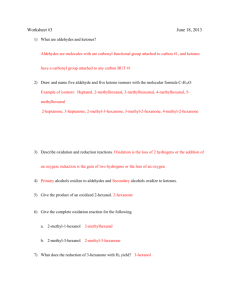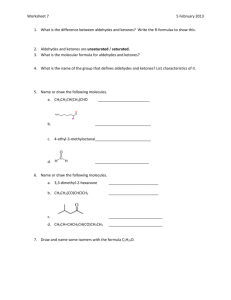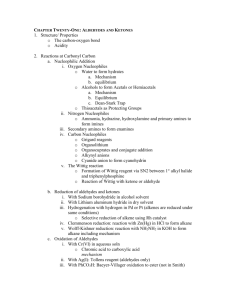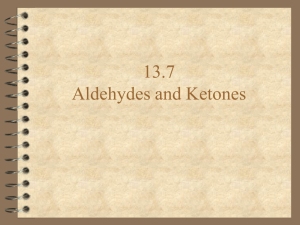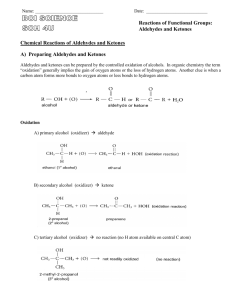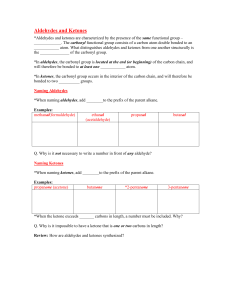Chemistry of Cooking
advertisement
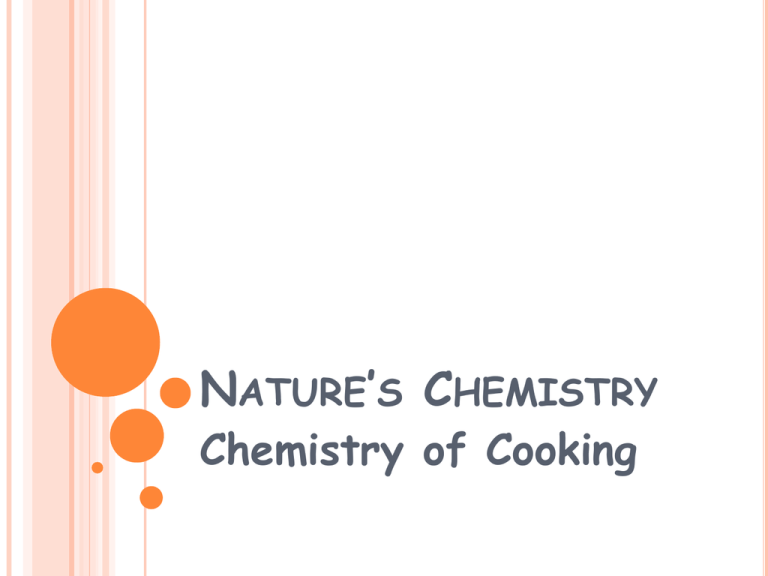
NATURE’S CHEMISTRY Chemistry of Cooking FLAVOURS IN FOOD Many of the flavours in foods are due to the presence of volatile molecules. Many flavour and aroma molecules belong to the family called aldehydes Overcooking food using either method will cause more flavour to be lost. The toxicity of aldehydes, however, can result in unfortunate symptoms such as severe headaches. ALDEHYDES AND KETONES Aldehydes and ketones both contain the carbonyl functional group, >C=O. Aldehydes based on the alkane hydrocarbons are called alkanals and the -al ending identifies the substance as an aldehyde. They have the functional group -CHO. Ketones which are based on the alkane hydrocarbons are called alkanones and the -one ending identifies the substance as a ketone. Ketones all have the >C=O group. Aldehydes You will be expected to name straightchain and branched-chain aldehydes, with no more than eight carbon atoms in their longest chain from structural formulae. You will also be expected to draw structural formulae and write molecular formulae given the names of straight-chain or branched-chain aldehydes. Ketones You will be expected to name straight-chain and branched-chain ketones, with no more than eight carbon atoms in their longest chain from structural formulae. You will also be expected to draw structural formulae and write molecular formulae given the names of straight-chain or branched-chain ketones. OXIDATION KETONES OF ALDEHYDES AND Oxidising agents such as copper (II) oxide, Fehling's (or Benedict's) solution, acidified potassium dichromate or Tollen's reagents will convert aldehydes to carboxylic acids The reaction is classed as an oxidation because of an increase in the oxidation: hydrogen ratio. Ketones do not undergo oxidation and this fact can be used to distinguish aldehydes from ketones. OXIDISING AGENTS Reagent Aldehyde Ketone Copper(II) oxide Black to Red-Brown No change Acidified Potassium Dichromate Orange to Green/Blue No change Fehling's (or Benedict's) solution Blue to Red-Brown No change Tollen's reagent Colourless to Silver No change PROTEINS Proteins are complex molecules made from long, amino acid chains which are also branched. The chains are held together by intermolecular bonding between the side chains of the constituent amino acids. Hydrogen bonds occur between the amide links and between other groups present in the molecule. Proteins form three-dimensional structures which are sheets, spirals or coils. COOKING PROTEINS When proteins are heated, during cooking, these intermolecular bonds are broken allowing the proteins to change shape (denature). These changes alter the texture of foods. For example, egg whites contain many molecules of a globular protein called albumen. When an egg is boiled or fried, the protein structure is irreversibly changed and a solid is made.
